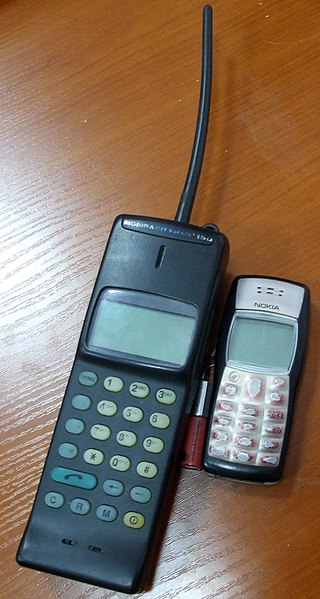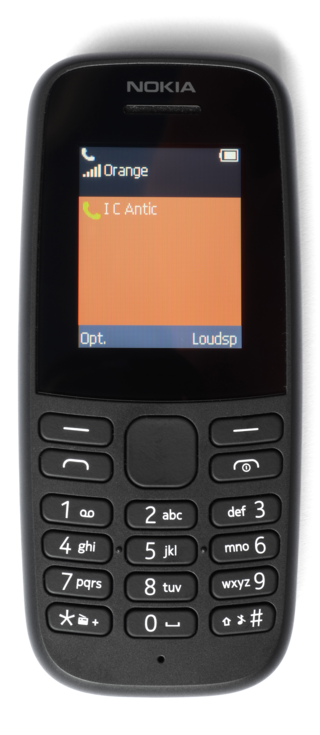
Short Message/Messaging Service, commonly abbreviated as SMS, is a text messaging service component of most telephone, Internet and mobile device systems. It uses standardized communication protocols that let mobile devices exchange short text messages. An intermediary service can facilitate a text-to-voice conversion to be sent to landlines.

3G is the third generation of wireless mobile telecommunications technology. It is the upgrade to 2G, 2.5G, GPRS and 2.75G Enhanced Data Rates for GSM Evolution networks, offering faster data transfer, and better voice quality. This network was superseded by 4G, and later by 5G. This network is based on a set of standards used for mobile devices and mobile telecommunications services and networks that comply with the International Mobile Telecommunications-2000 (IMT-2000) specifications set by the International Telecommunication Union. 3G is used in wireless voice telephony, mobile Internet access, fixed wireless Internet access, video calls and mobile TV.

NMT is an automatic cellular phone system specified by Nordic telecommunications administrations (PTTs) and opened for service on 1 October 1981. NMT is based on analogue technology and two variants exist: NMT-450 and NMT-900. The numbers indicate the frequency bands used. NMT-900 was introduced in 1986 and carries more channels than the older NMT-450 network.
The Nokia 3310 is a discontinued GSM mobile phone announced on 1 September 2000, and released in the fourth quarter of the year, replacing the popular Nokia 3210. It sold very well, being one of the most successful phones, with 126 million units sold worldwide, and being one of Nokia's most iconic devices. The phone is still widely acclaimed and has gained a cult status due to its reputation for durability.
Adaptive Multi-Rate Wideband (AMR-WB) is a patented wideband speech audio coding standard developed based on Adaptive Multi-Rate encoding, using a similar methodology to algebraic code-excited linear prediction (ACELP). AMR-WB provides improved speech quality due to a wider speech bandwidth of 50–7000 Hz compared to narrowband speech coders which in general are optimized for POTS wireline quality of 300–3400 Hz. AMR-WB was developed by Nokia and VoiceAge and it was first specified by 3GPP.

The history of mobile phones covers mobile communication devices that connect wirelessly to the public switched telephone network.

Nokia 8210 is a mobile phone by Nokia, announced on 8 October 1999 in Paris. At the time, it was the smallest, lightest Nokia mobile phone on the market. A primary selling point of its design was its removable cover that allowed for easy customization. Six differently coloured Xpress-on covers are available, as well as many third-party ones.
Wi-Fi calling refers to mobile phone voice calls and data that are made over IP networks using Wi-Fi, instead of the cell towers provided by cellular networks. Using this feature, compatible handsets are able to route regular cellular calls through a wireless LAN (Wi-Fi) network with broadband Internet, while seamlessly change connections between the two where necessary. This feature makes use of the Generic Access Network (GAN) protocol, also known as Unlicensed Mobile Access (UMA).

The Nokia N95 is a mobile phone produced by Nokia as part of their Nseries line of portable devices. Announced in September 2006, it was released to the market in March 2007. The N95 ran S60 3rd Edition, on Symbian OS v9.2. It has a two-way sliding mechanism, which can be used to access either media playback buttons or a numeric keypad. It was first released in silver and later on in black, with limited edition quantities in gold and purple. The launch price of the N95 was around €550.

Some mobile phones support use of two SIM cards, described as dual SIM operation. When a second SIM card is installed, the phone may allow users to switch between two separate mobile network services manually, have hardware support for keeping both connections in a "standby" state for automatic switching, or have two transceivers to maintain both network connections at once.
In telecommunications, long-term evolution (LTE) is a standard for wireless broadband communication for mobile devices and data terminals, based on the GSM/EDGE and UMTS/HSPA standards. It improves on those standards' capacity and speed by using a different radio interface and core network improvements. LTE is the upgrade path for carriers with both GSM/UMTS networks and CDMA2000 networks. Because LTE frequencies and bands differ from country to country, only multi-band phones can use LTE in all countries where it is supported.
The BlackBerry Curve was a brand of professional smartphones that were manufactured by BlackBerry Limited from 2007 until 2013.

The Nokia Lumia 1520 was a flagship Windows Phone phablet smartphone designed and produced by Finnish telecommunications manufacturer Nokia in partnership with American software manufacturer Microsoft. The device was first announced at the Nokia World event on 22 October 2013 in Abu Dhabi, alongside its mid-range phablet stablemate the Nokia Lumia 1320 and Nokia's 10.1 inch Windows RT tablet the Nokia Lumia 2520. Until its discontinuation in the United States on 7 April 2015 the phone served as the flagship device for Nokia's Lumia Series and Microsoft's mobile effort. On 6 October 2015 Microsoft officially announced its flagship phablet successor, the Microsoft Lumia 950 XL, with availability sometime in November 2015.

SmarTone Telecommunications Holdings Limited (0315.HK), listed in Hong Kong since 1996 and a subsidiary of Sun Hung Kai Properties Limited, is a leading telecommunications provider with operating subsidiaries in Hong Kong and Macau, offering voice, multimedia and mobile broadband services, as well as fixed fibre broadband services for both consumer and corporate markets. SmarTone spearheaded 5G development in Hong Kong since May 2020, with the launch of its territory-wide 5G services. SmarTone is also the first in Hong Kong to launch Home 5G Broadband service.

Nokia Series 30+ is a software platform and application user interface used for Nokia-branded mobile devices. The platform was introduced by Nokia in September 2013, first appearing on the Nokia 108, and has been the main Nokia feature phone operating system after the end of the Series 30 and Series 40 platforms in 2014. Despite the similar name and user interface, S30+ is technically completely different and unrelated to S30.

Human Mobile Devices (HMD), formally HMD Global, is a Finnish mobile phone manufacturer. The company is made up of the mobile phone business that the Nokia Corporation sold to Microsoft in 2014, then bought back in 2016. HMD began marketing Nokia-branded smartphones and feature phones on 1 December 2016. The company has exclusive rights to the Nokia brand for mobile phones through a licensing agreement. The HMD brand was initially only used for corporate purposes and does not appear in advertising, whereas the name "Nokia Mobile" is used on social media. As it was launched, the acronym HMD stood for Hon Hai Mobile Devices. This was in reference to the main shareholder at the time of its creation: the Taiwanese group Foxconn. In January 2024, HMD rebranded to 'Human Mobile Devices', and will use their own branding on future devices alongside that of Nokia.

KaiOS is a mobile Linux distribution for keypad feature phones based on the Firefox OS open-source project. It is developed by KaiOS Technologies Limited; a company based in Hong Kong, whose largest shareholder is Chinese electronics conglomerate TCL Corporation. KaiOS runs on feature phones or wireless home phones made with low-power hardware and low power consumption. KaiOS supports modern connectivity technologies like 4G LTE, VoLTE, GPS, and Wi-Fi. KaiOS runs HTML5-based apps. KaiOS supports over-the-air updates and has a dedicated app marketplace called KaiStore. Some applications are preinstalled onto the phone, including Facebook and YouTube. As of 1 April 2020, there are 500+ apps in KaiStore. The mobile operating system is comparatively lightweight on hardware resource usage, and is able to run on devices with just 256 megabytes (MB) of memory.
Android Go products were first showcased at MWC 2018 with six products: Nokia 1, ZTE Tempo Go, Alcatel 1X, General Mobile GM8 Go, Lava Z50, and Micromax Bharat Go. The Blu Vivo Go became the first Android Go device with Android Pie Go edition.

Nokia 105 (2019), also known as Nokia 105 4th Edition, is a Nokia-branded feature phone developed by HMD Global. It was unveiled on 24 July 2019 alongside the Nokia 220 4G and released in September 2019. The phone is available in three colours; blue, pink and black.













